
Ben Hoffman
Last Yard
Note: Since writing this blog post, SignIQ has changed its name to Last Yard.
Ticketing is one of the few opportunities retailers have to engage with their customers in the store. It is the silent salesman that guides the customer, answers questions, helps them discover new products, removes the barrier to decision making, identifies offers & promotions and ultimately influences their buying decisions.
Online retailers are challenging brick & mortar stores to remain competitive, profitable & relevant. Great retail brands offer customers a tangible difference, unique experiences and inspiration.
A great experience can build customer loyalty and trust, without that experience, customers will be driven by convenience and cost.
Once a customer is in your store there are 5 main areas where retailers engage and create an experience with their customers:
Through the design of the store (appearance and atmosphere)
Range, merchandising and pricing strategies
Staff customer service
Digital experiences
Ticketing, shelf talkers and labels (in-store communication)
Decisions are made at the shelf
There are many claims about the level of in-store purchase decisions that are made at the shelf (anywhere from 60% to 82%). The best known would probably be the 2014 study from POPAI that suggests “82% of all shopping decisions (are) made in the store”.
Other reports suggest that globally, almost 30% of shoppers wait until they are in the store to decide which brand to buy and 10% of shoppers buy a different brand from the one they had planned to purchase. Additionally, 10% of shoppers who intend to buy will leave the store empty-handed.
Without being sure of the real-world stats, we can all accept that there is a lot of in-store purchase decision making. Influencing the decision at the shelf can increase both the sale of individual brands and overall sales through increasing the customers basket size.
Good ticketing can influence decisions and increase sales
In-store ticketing won’t get the customers into your store, but once they are in the store it is the best way to influence the customer and increase their basket size.
This is achieved in several key ways:
Impulse purchases
Discovering new products (or new uses for products)
Cross merchandising
Helping the customer to make a decision
Impulse purchases based on offers
Customers love a good deal. Offers can create impulse purchases by triggering this very primitive response, either through unplanned purchases or buying higher volumes.
However, having great value offers are not enough if they are not clearly advertised to the customer. The value of the offer should be understandable at a glance and the customer should not be relied on to mentally calculate the value or savings they get from an offer.
The easier it is for the customer to understand the value of the offer at a glance, the more offers they can scan while browsing and the more opportunities there are to trigger value based impulse decisions.
Many promotional tickets are only effective when shoppers take the time to study the offers available products they were already planning on purchasing. If a promotional ticket only focuses on the special price, then it is only effective if the customer knows (of by heart) the regular price for a product and does the quick mental calculation. This type of price-based ticket is then only effective on products that customers are very familiar with the normal price, usually just the everyday items.
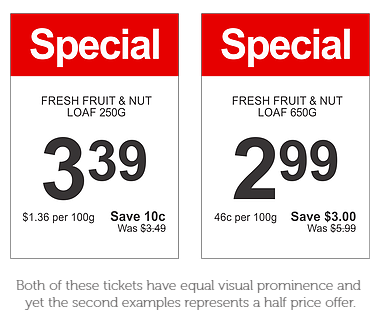
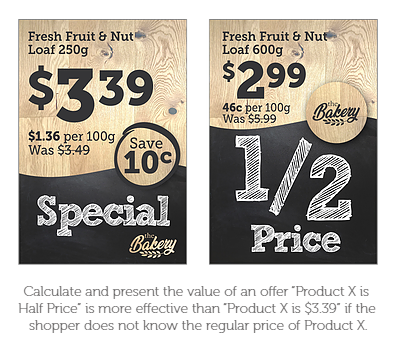
Discovering new products
One of the advantages of bricks-and-mortar stores is to provide an environment where shoppers can truly browse and discover new products or old products they had forgotten.
It is becoming more important for retailers to aid in the discovery of new products and with a bricks-and-mortar store, shoppers can wander a store and take in thousands of products at a glance, in this way, discovering products is a very natural and organic experience.
Compared with the online browsing experience, which is largely scrolling through long lists of single product images, the act of shopping in a physical store for some shoppers is an enjoyable one of hunting and discovery.
In-store ticketing that can call out new products and varieties (or even calling out old products to try again) and aids in the discovery is an experience that cannot be replicated for many online retailers. This competitive advantage should be embraced and must become a key ingredient for a good in-store customer experience.
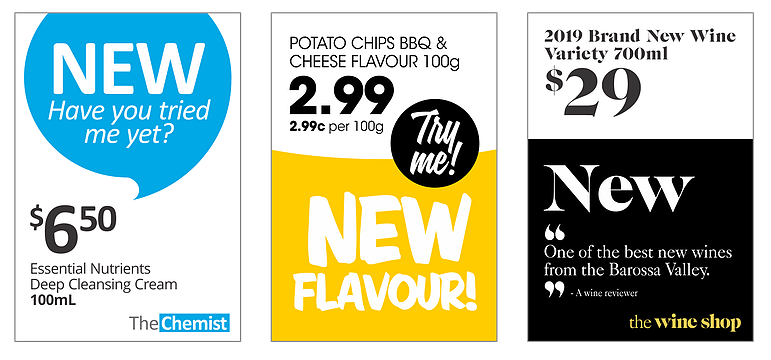
Cross merchandising
Cross merchandising is a strategy that boosts sales by placing complementary items alongside one another in stores. There are many classic cross merchandising examples, such as putting soft drinks next to savory snacks. The idea is simple: If customers are looking for one of these items, they might also need the other – even if they don’t know it before they see the product on the shelf.
This form of merchandising is incredibly common in grocery stores, but any retailer can use this strategy to boost sales. Cross-merchandising has quietly exploded online as the digital platform is a perfect medium for easily showing “customers also purchased” and bundle promotion offers.
In stores however, there are limits on how many products you can physically co-locate to take advantage of this effect.
This is where ticketing can play an incredibly important role and expand the cross-merchandising opportunities. In some ways ticketing can be a more effective method of cross promotion as the retailer can be more explicit in creating the relationships in the shoppers’ mind and can take advantage of 100’s or even 1000’s of opportunities.
But more importantly, the decisions on which products to cross-merchandise can be data driven, by understanding historical buying patterns. Using this historical data, the creation of cross-merchandising tickets can be largely automated and does not require constant product shelf changes.
Display cross-merchandising combinations which tap into shopper missions.
When you know your customer missions, you’re able to create cross-merchandising messages and when shoppers can relate to the messages, they’re more likely to be persuaded to make a purchase.
Examples of cross merchandising messaging in-store:
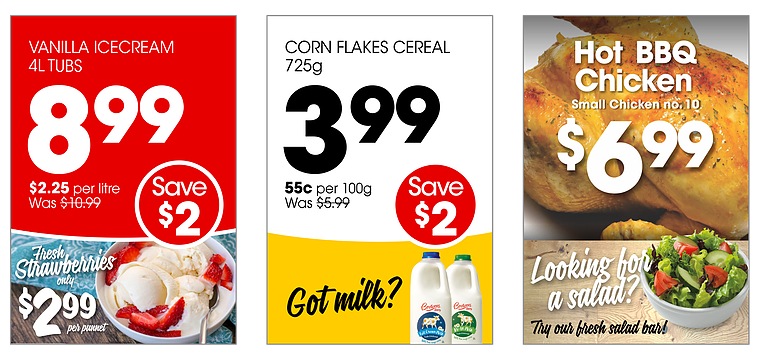
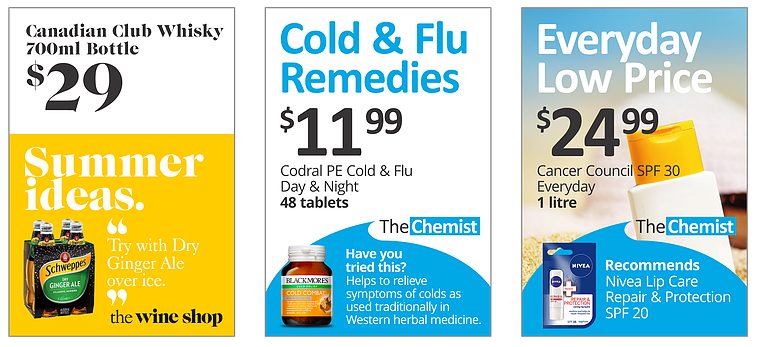
Helping shoppers to make a buying decision
Understanding and responding to the motivations of the modern shopper is critical to providing them the information they need to make a buying decision.
The Modern customers are basing their buying decisions on an ever-growing set of criteria:
Value
Convenience
Health
Environmental & ethical
Value
Many shoppers always have and always will shop for value. Ticketing should provide clear information about the promotion or everyday low price and allow the customer to understand the value at a glance. Traditional price based tickets can hide or obscure the real value in the store. Strong call outs to great value offers can create an impression of value across the entire store, not just individual products.

Convenience
Many shoppers are time poor which means they are looking for ideas that will make their life easier (eg Meal ideas) or reduce the time spent in store.
Ready-to-go meals are a growing segment and it is important to clearly identify the options and promote them in the store. In addition to the ready-to-go products, sometimes it is the suggestion or the idea that the shopper is looking for. Many shoppers enter the store in the hope of being inspired, whether it is “what to prepare for diner tonight” or what “wine would go with this occasion”.
Provide ideas or inspiration for customers that are browsing with the use of “Easy meal ideas”, “Managers recommendation” etc.
Health
Many factors go into shoppers’ decisions to buy healthy products, including how those products were produced. Research shows that more mainstream shoppers are turning to local, healthy, natural, organic, vegetarian and vegan products.
In addition to a general awareness of health products, there is also a growing number of shoppers looking for allergy related products such as Gluten, Dairy, and allergen free products.
Stores that make the shopping experience easier and quicker by clearly indicating healthy options, allergens & dietary preferences with well-designed tickets and labels will create a desirable experience for shoppers.
Stores have traditionally placed similar themed products together (eg Gluten Free section) and this is getting progressively more difficult as products can belong to multiple categories (GF, Vegetarian & Fair Trade). The only way to make sense of the products that are offered in the store is through clear well designed ticketing.
Environmental & Ethical
Local, independent, fair trade, supply chain, free-range, recycling and even Vegan are often ethical choices that influence a customers decision.
The purchase of ethical products with high awareness and broad appeal, like fair trade and locally produced goods, is on the rise along with people’s desire to minimise their impact on the environment.
What is interesting is that people will make what they think are “better” choices in one area of their lives but not necessarily in another, these are individual issues and therefore there is no one-size-fits-all solution.
Any information that can be clearly displayed to the customer in a uniform and consistent format will help them discover the products that are important to them. If you rely on the product packaging to inform the shopper then you are losing many opportunities to call these products out.
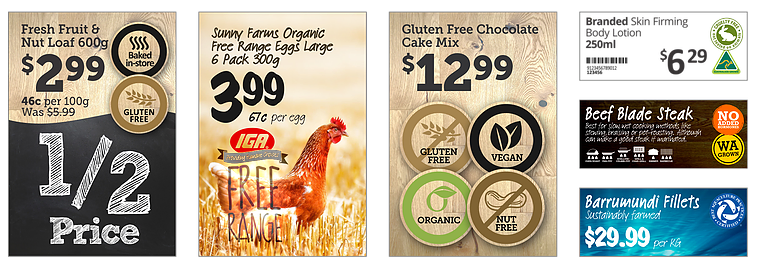
Create an experience that builds trust & loyalty
Customers have been slowly moving away from the old model of bricks-and-mortar retail focused on the products being sold with a minimal in-store experience.
Instead shoppers are seeking more engaging and inspirational experiences. With the new online purchasing habits and the newer digital sharing economy, this trend has been led by millennials and their preference for experiences over things.
Millennial customers (under 35) are different to previous generations. They tend to prefer new brands, especially in food products and are generally willing to pay for special things and experiences (including daily food), for everything else, they seek value.
Ticketing can play a large part in the experience by providing customers the information they need to make choices based on the criteria that is important to them and it is a way to aid customers in the discovery of new products or to provide inspirational ideas.
